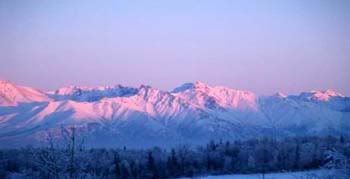




Wasilla is a city in the Matanuska-Susitna Borough in the U.S. state of Alaska, part of the Anchorage Metropolitan Statistical Area. As of the 2000 census, its population was 5,469, but the 2007 estimate gives a population of 9,780. The census estimate moves Wasilla to the position of the fourth largest city in Alaska, after Anchorage, Fairbanks, and Juneau.
Wasilla was named after a respected local Dena'ina Indian, Chief Wasilla, whose name was derived from the Russian name 'Vasili'. The city is located at 61°34′54″N 149°27′9″W and has a total area of about 12.4 square miles.
Wasilla is located midway between the Matanuska Valley and the Susitna Valley, on the George Parks Highway. The Dena'ina (Tanaina) Indians called the area Benteh, meaning 'among the lakes'. The present city lies between Wasilla Lake and Lake Lucille, 43 highway miles northeast of Anchorage, about one hour's drive, and about 10 miles west of Palmer. About one third of the people of Wasilla commute to work into Anchorage every day.
January temperatures range from 4 °F (−16 °C) to 29 °F (−2 °C); July temperatures vary from 47 °F (8 °C) to 78 °F (26 °C). The average annual precipitation is 17 inches (430 mm), with 50 inches (130 cm) of snowfall.
As of the census of 2000, there were 2,119 housing units at an average density of 180.9/sq mi. The racial makeup of the city was 85.46% White, 0.59% Black or African American, 5.25% Native American, 1.32% Asian, 0.13% Pacific Islander, 1.32% from other races, and 5.94% from two or more races. 3.68% of the population were Hispanic or Latino.
The median income for a household in the city was $48,226, and the median income for a family was $53,792. Males had a median income of $41,332 versus $29,119 for females. The per capita income for the city was $21,127. About 5.7% of families and 9.6% of the population were below the poverty line, including 12.6% of those under the age of 18 and 9.7% of those 65 and older.
Approximately 35 percent of the Wasilla workforce commutes to Anchorage. The local economy is diverse, and residents are employed in a variety of city, borough, state, federal, retail and professional service positions. Tourism, agriculture, wood products, steel, and concrete products are part of the economy. One hundred and twenty area residents hold commercial fishing permits. Wasilla is home to the Iditarod Trail Committee.
The George Parks Highway, Glenn Highway and other roads connect the city to Anchorage, the remainder of the state and Canada. The Alaska Railroad serves Wasilla. A town airport, with a paved 3,700-foot airstrip, provides scheduled commuter and air taxi services. Floatplanes land at Wasilla Lake, Jacobsen Lake and Lake Lucille. There are 10 additional private airstrips in the vicinity.
The history of Wasilla begins with the history of Knik, the first boom town in the Mat-Su Valley, which by 1915 boasted a population of 500. The town served the early fur trappers and miners working the gold fields at Cache Creek and Willow Creek.
Wasilla was established in 1917 with the construction of the Alaska Railroad. Wasilla’s proximity to the gold fields and railroad service lured Knik residents to relocate in the new town — some of them even dragging their homes and businesses with them. In a few short years, Knik became a ghost town. The current townsite was established in 1917 at the intersection of the Knik-Willow mining trail and the newly constructed Alaska Railroad. It was a supply base for gold, notably at Hatcher Pass, and coal mining in the region through World War II.
The town of Wasilla was incorporated in 1974. In 1994 a statewide ballot initiative to move the capital of Alaska to Wasilla was defeated by a vote of about 116,000 to 96,000. In January 2006 a new hospital, Mat-Su Regional Medical Center, opened. It is situated outside the city limits halfway between Wasilla and its twin city of Palmer. In February 2008, urban sprawl and dwindling snow resulting from climate change forced organizers of the Iditarod race to bypass Wasilla permanently. The race had its start in Wasilla from 1973 to 2002, the year when reduced snow cover forced an "temporary" change to Willow.
Thanks for reading.
Technorati Tags: wasilla, alaska, wasilla alaska, iditarod, matsu valley, towns, cities, united states, alaska, sarah palin, almost wordless wednesday
Generated By Technorati Tag Generator















1 comments:
Breathtaking photos Matthew! I grew up in Alaska and although Anchorage was my hometown, I spent most of my summers at my grandparents homestead in Wasilla - before it turned into the bustling city it is today! That was only about 30 years ago too! :) As I'm typing my comment, I look over and see info about FOH BOH. I need to check that out! Love your blog!
Post a Comment